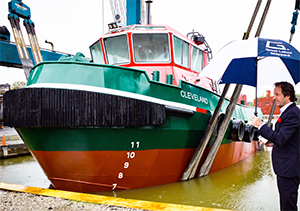When the time came to upgrade Great Lakes Towing Co.’s fleet, company President Joe Starck wanted a design that matched the existing boats’ capabilities while adding power and versatility.
With the Damen Stan 1907 ICE class, a 65-foot workhorse already working ports around the world, he found what he was looking for. Great Lakes is building the first vessel, Cleveland, at its Cleveland shipyard along Lake Erie. Delivery is set for June 2017.
The company plans to build at least nine more of the twin-screw, 2,000-hp tugs in the coming years. Each vessel in this Great Lakes class will be built to ABS Class A1 towing vessel rules. Cleveland is expected to be the first such vessel operating in the United States built specifically to meet U.S. Coast Guard Subchapter M standards.
“The boat is really a modern-day version of the simple tug that we have been operating for over 100 years,” Starck said in a recent interview at the company’s Cleveland headquarters.
“It’s very similar in size (to our existing tugs), it’s twin-screw as opposed to single-screw, 2,000 hp as opposed to most of our tugs, which are in the 1,500-hp range, and it’s nearly doubling our bollard pull,” he continued.
Nearly 40 Damen Stan 1907 ICE-class tugs are already working around the world, including in cold-weather ports in the Netherlands and Russia. These tugs are capable of ship handling, docking, icebreaking and towing in the Great Lakes and along the coast. They can be crewed with two people to reduce operations costs. Coming in under 79 feet also simplifies the U.S. regulatory picture.
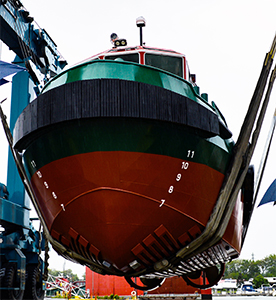 |
|
The channel cooler visible on Cleveland’s hull required “well over 1,000 man-hours” to install. |
|
Great Lakes Shipyard |
“Its main function is towing, pushing, mooring, it can (perform) firefighting,” said Mark Honders, manager of design and licenses with Damen Shipyards in Gorinchem, Netherlands. “It’s pretty versatile. It can be used for any type of operation you want to do in the harbor.”
Great Lakes Towing operates roughly 30 harbor tugs in 11 U.S. ports between Duluth, Minn., and Buffalo, N.Y. Many of its tugs work in shallow water bodies or rivers where debris is a concern, making conventional propulsion advantageous. The harsh Great Lakes winters also required tugs with sturdy, reinforced hulls to break ice more than a foot thick.
Shipping slows down considerably during the winter months, but during roughly nine months of open water, the company handles about 1,500 towing jobs. This includes Great Lakes ships known as “lakers,” articulated tug-barge units pushing oil products, and “salties” that arrive from around the world via the St. Lawrence Seaway.
The tug Cleveland, which will work in and around its namesake city, also must navigate the Cuyahoga River, which has a series of S-curves as it enters Lake Erie. Cleveland-based tugs can handle ships up to 700 feet long, usually with a single tug out front and sometimes with a second at the stern. Given the narrow river, the tugs tow ships back out into the lake stern-first.
Harbor tugboat crews used to operating in the Gulf of Mexico or along either coast might be skeptical of a 2,000-hp vessel for ship handling. But Starck said the company has never had complaints about horsepower. If a specific ship requires more than a single tug can offer, a second tug will be deployed. “If that’s still not enough, we’ll add another,” he said.
Great Lakes has typically hired Jensen Maritime Consultants to design its newbuilds, most recently its 74-foot, 3,400-hp HandySize tugboats. The shipyard completed its fourth HandySize-class tug in September 2016 for a customer in Guatemala.
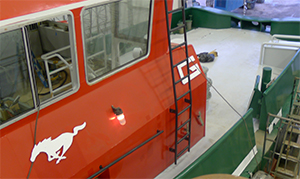 |
|
The Work Horse logo pays homage to Great Lakes Towing Co.’s tugs from the early 1900s, which were known as “the workhorses of the Great Lakes.” |
|
Douglas Barrow |
This time around, however, Great Lakes wanted to start with a proven design rather than develop an entirely new concept. The Damen Stan 1907 ICE-class design dates back to 2007, Honders said, and it evolved from an earlier design that goes back even further.
The ICE-class variant of the Damen Stan 1907 has bigger shafting and an ice belt of reinforced steel installed around the waterline. It also features extra plate thickness, extra brackets and extra fendering. The frame distance is 275 mm instead of 550 mm for additional vertical stiffness.
The design has two distinguishing elements. One is the channel cooler system welded along the underside of the hull to cool the engines and generators while also reinforcing the hull. The other is the lack of exhaust trunks and stacks, which improves the captain’s view astern. Instead of piping carrying the dry exhaust up and out, it runs straight back and leaves through the stern.
The exhaust ends are located above the waterline and the piping is designed such that water will not flow back into the engines, according to shipyard General Manager Douglas Barrow. The exhaust design was a first for Barrow, who came to Great Lakes about 15 months ago after a long career at several prominent Gulf Coast shipyards.
“It basically maxes your visibility by eliminating any stacks going up and blocking your view aft. Especially for relatively smaller tugs, you have to look up or aft quite a bit because you’re often working from the aft end,” Honders said of the exhaust system that is standard on Damen tugs this size.
The channel coolers, which also are part of the standard design, could be removed from subsequent boats in the Great Lakes class. Barrow said installing them required “well over 1,000 man-hours.” Future vessels may use grid coolers to simplify construction and reduce cost.
Although the Damen design is effectively “off the shelf,” adapting the plans to U.S. regulations and building techniques required extensive re-engineering and redrawing. For example, Starck said the Damen package called for four or five different hull plates where one would do.
“We have redrawn the entire boat and relofted the whole thing, eliminating all those seams,” he said, adding that the initial design-build process created a learning curve for the shipyard and the Damen team.
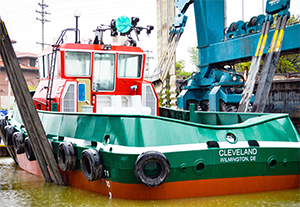 |
|
Great Lakes-class tugs send engine and generator exhaust out through the stern. There are no exhaust stacks. |
|
Great Lakes Shipyard |
“They are much less sensitive to labor costs than we are. In the U.S., we are very sensitive to labor costs and Great Lakes Shipyard is doing everything we can to squeeze every man-hour out of the construction process, so there were a lot of changes made,” Starck said. “Most of the changes we made were to reduce the cost of construction.”
Cleveland has a forward pilothouse common in Damen designs with a split-level layout to maximize space. From the outer deck, one can walk up a short staircase to the wheelhouse or down a stair to the accommodations deck. From there, crew can step down into the engine room.
The wheelhouse is equipped with Furuno radars and navigation equipment and a Simrad autopilot system in a console provided by Beier Electronics with remote diagnostics capability. Pilothouse windows provide 360-degree visibility.
Cleveland is designed as a day boat, so it has minimal accommodations. The forward accommodations spaces include pipe racks for berthing, but the space also can be used for storage. There is also a small galley with a settee.
“There is not a lot of fluff in the vessel. It’s simple and straightforward,” Barrow said. “That makes it easier to operate and easier to maintain. We’re looking forward to putting her into service in our fleet.”
In the small but functional engine room, there are two MTU 8V 4000 Tier 3 engines each producing 1,000 hp, and twin Kohler 65-kW generators. The mains turn 71-inch props in Kort nozzles through Twin Disc reduction gears. The Damen package for this vessel included the props and rudders, as well as rubber fendering protecting the bow.
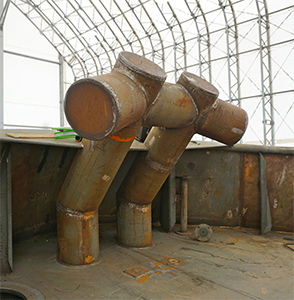 |
|
The H-bitt on the bow is “canted” to prevent hull damage when working in a ship’s flare. |
|
Casey Conley |
Lloyd’s has approved the Damen design. Revised drawings were reviewed by ABS, which also has been in attendance throughout construction at the Cleveland shipyard. All 10 of the tugboats will be built to Coast Guard Subchapter M standards.
Cleveland is scheduled to join the Great Lakes fleet in June and it will be assigned, not surprisingly, to work in Cleveland. Future deliveries will be assigned to Cleveland and other high-volume Great Lakes ports such as Detroit, Toledo, Duluth and Chicago. The company plans to retire two existing vessels for each new tug it builds. Some of its current tugs are pushing 120 years old.
Great Lakes is treating Cleveland as a prototype vessel. Crews will get the chance to work on the boat and determine what they like and do not like about design elements and features. The company will take this input into account when it adjusts or modifies the design for subsequent tugs in the class. Construction on the second boat will likely begin in summer 2017 with delivery expected about nine months later.
“We will make whatever changes to improve the package and implement them in the second tug, and that will really be the first of the series,” Starck said. “This prototype is really like version zero, and then we’ll go to version one and try to keep them all identical.”
“We will keep the same machinery package, the same hull form and basically the same nav package,” he continued. “It is really a simple boat.”

